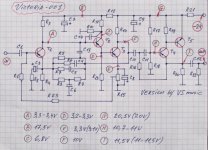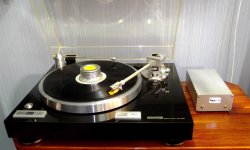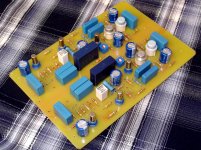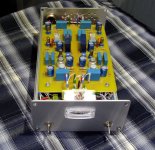Not exactly a bad habit! I do it the same way, too lazy to learn some schematic design software.
Best regards!
Best regards!
Thanks! And now compare with AC150 ;-) : https://www.web-bcs.com/pdf/Tf/AC/AC150.pdf
Best regards!
I agree. The noise properties of the AC-150 are better . But I don't have such transistors yet . But I had a few dozen 122's . Besides-Telefunken ....Legend ...😉
And here is another scheme that I really liked for its sound . I have already written about it here , but I probably incorrectly published the scheme and photo of the product here - the pictures have not been saved . This is the scheme of the corrector from the radiola Victoria-001 ( 1972, USSR). I changed the original scheme slightly for several reasons . My version is like this . This Phono preamp has a rumble filter with a very steep cut-off front - very effective on uneven LP's .@ vsmusic:
Are there circuit drawings available of your low noise Ge-preamps?

View attachment Specification.pdf
Last edited:
I've read this topic . I wanted to try to make such a product . But it hasn't come to that yet . But I recently retired . And now I don't work . Maybe I'll make one . If this happens, I will definitely report the result .What about this ?
GERMANIUM Single ended Class A Headphone Amp.
Last edited:
I like to listen to the Beatles , Jethro Tull, Caravan, Curved Air and others using the 60s-70s Phono preamp . It's beautiful.
Well, your preamp appears to match exactly your favourite artists' music 😉.
Btw, love all of them, too!
Best regards!
Btw, love all of them, too!
Best regards!
Well, your preamp appears to match exactly your favourite artists' music 😉.
Btw, love all of them, too!
Best regards!

I've read this topic. I wanted to try to make such a product. But it hasn't come to that yet... Maybe I'll make one. If this happens, I will definitely report the result.
Currently finishing this circuit (AC125, AC130 (NPN!), AC132, 2xAC124), with a single pot semi-shelving tone controle as a hp-amp to dress the digital hiss from modern sources.
vsmusic, your drawings and builds are both stencil-like: beautifull!
I'm lazy when drawing, with all the calculations scattered around the components. Lovely to read cyrillic, I leave it that way.
Looked up my local supplier for AC150... alas. 22 types AC, 5 types ACY, 12 types AD and exotic AD's, but no AC150. I'll ask if they have a source.
Looked up my local supplier for AC150... alas. 22 types AC, 5 types ACY, 12 types AD and exotic AD's, but no AC150. I'll ask if they have a source.
Look for AC-151 . Especially 151r - they are about 150th in terms of noise level
AC 116 121 124 125 128 130(npn) 131 132 134 ... ... 152 153 161 172(npn) 175(npn) 178 179(npn) 180 181(npn) 182 183(npn) 184 187K
I have another more remote supplier in mind, I'll ask them too.
I have another more remote supplier in mind, I'll ask them too.
....a Germanium phono preamp puts out noise like the Niagara falls 😛…
This is historical, not chemical.
CLEAN devices are low-hiss. (Surface leakage matters too, but is related.)
You can make a "working" part with fairly dirty Germanium. Early Ge (late 1950s) metallurgy was advanced for its time, but still flawed.
To make useful Si parts took a lot more refinement. (Andy Grove was a large part of this before he moved to other fields.) Purity and surface states were greatly refined by late 1960s/1970.
In the US, Ge was already "obsolete" (except a lingering power market) and the refinements made in Si technology didn't carry over. In the USSR and even in Japan, Ge production continued and took-up Si tricks. Ge stayed a low-cost product and cleanliness standards were sometimes lax. But if you get good late-production Ge parts (not rejects, not culls) the hiss can be quite low.
It also helps to Know Your Part. Si is not too fussy. Early Ge had narrow optimums. I remember the first BBC Ge preamp had an elaborate biasing, and I finally tumbled that the Ge part they had really had to be biased that tight to be predictably quiet.
@PRR I have some germanium transistor from BEL (Bharat Electronics Limited ) produced between 2002 to 2008(Last Production) . They are very clean device for GE standards and had higher gains than similar Philips/Mullard Transistor . Packages were smaller for AC125 like BC108 but big for AC128/AC187/AC188 . They still produced now and then until 2012 for Military .
Are the any datasheets for Ge devices that give voltage and current noise graphs?
Ge is a superior semiconductor than silicon in several regards, but its very low max temperature and low thermal conductivity handicap it (for instance I suspect a Ge device might fail modern automotive qualification on temperature grounds alone).
Ge is a superior semiconductor than silicon in several regards, but its very low max temperature and low thermal conductivity handicap it (for instance I suspect a Ge device might fail modern automotive qualification on temperature grounds alone).
Mark, would you please Elaborate on this? Thanks!Ge is a superior semiconductor than silicon in several regards…
Well, they were very common in automotive radios of the 1960, at least here in Germany....but its very low max temperature and low thermal conductivity handicap it (for instance I suspect a Ge device might fail modern automotive qualification on temperature grounds alone).
Does anyone remember the AD161/162 »power« devices that almost any car radio of that era featured? Their case was similar, but not identical at all to TO-66. Per chance I've got my hands on dozens of pairs of them some years ago and still don't know what to do with these…
Best regards!
Mark, would you please Elaborate on this? Thanks!
Well, they were very common in automotive radios of the 1960, at least here in Germany.
Does anyone remember the AD161/162 »power« devices that almost any car radio of that era featured? Their case was similar, but not identical at all to TO-66. Per chance I've got my hands on dozens of pairs of them some years ago and still don't know what to do with these…
Best regards!
Certainly, AD161/161 für eisenlose Endstufen so um die 4 Watt
Yes, thanks, I know that, as it's the same application as in contemporary car radios. But whom do just four watts suffice?
Maybe I'd try an all Germanium guitar practice amp? I've also got some stock of ancient small signal Ge PNP's...
Best regards!
Maybe I'd try an all Germanium guitar practice amp? I've also got some stock of ancient small signal Ge PNP's...
Best regards!
AD161/162 in many 70's Philips equipment and a rare british brand (BTR?) too.
Still available. I have some interest however to build a Ge-Hiraga out of them.
Still available. I have some interest however to build a Ge-Hiraga out of them.
In the early 70s, automobile radios with germanium transistors were produced in the USSR .Are the any datasheets for Ge devices that give voltage and current noise graphs?
Ge is a superior semiconductor than silicon in several regards, but its very low max temperature and low thermal conductivity handicap it (for instance I suspect a Ge device might fail modern automotive qualification on temperature grounds alone).
- Home
- Amplifiers
- Solid State
- germanium Preamp?


